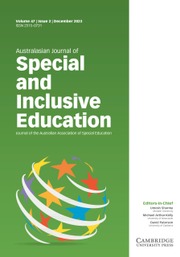No CrossRef data available.
Article contents
Bridging the Research-to-Practice Gap: Implementing the Research-to-Practice Model
Published online by Cambridge University Press: 24 May 2018
Abstract
In recent years, researchers have worked closely with parents, teachers, other school staff, and external stakeholders to increase knowledge on ways to effectively teach children and adolescents with disabilities in mainstream school settings. State, national, and global directives have encouraged the implementation of research-based practices and contributed to advocacy efforts for students with and without disabilities. In a longitudinal comparative case study, Grima-Farrell (2017) responded to these movements by striving to enhance teacher knowledge on how to effectively implement and sustain the use of validated teaching approaches to maximise the student engagement and success of all students. This paper specifically reports on the school-based efforts of 6 experienced teachers as they strive to implement research-based practices to respond to the diverse needs of their students. Results are presented using the research-to-practice model (Grima-Farrell, 2017) as a conceptual framework for guiding instructional decision-making through the implementation and sustained use of validated educational research approaches.
Keywords
- Type
- Special Education Perspectives
- Information
- Copyright
- Copyright © The Author(s) 2018
Footnotes
*This manuscript was accepted under the Editorship of David Paterson.


